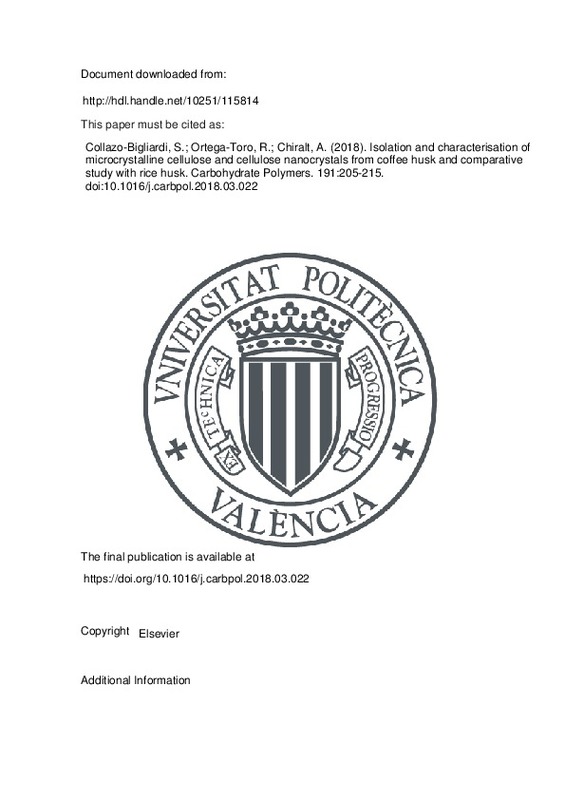JavaScript is disabled for your browser. Some features of this site may not work without it.
Buscar en RiuNet
Listar
Mi cuenta
Estadísticas
Ayuda RiuNet
Admin. UPV
Isolation and characterisation of microcrystalline cellulose and cellulose nanocrystals from coffee husk and comparative study with rice husk
Mostrar el registro sencillo del ítem
Ficheros en el ítem
| dc.contributor.author | Collazo-Bigliardi, Sofía
|
es_ES |
| dc.contributor.author | Ortega-Toro, Rodrigo
|
es_ES |
| dc.contributor.author | Chiralt, A.
|
es_ES |
| dc.date.accessioned | 2019-01-18T08:15:54Z | |
| dc.date.available | 2019-01-18T08:15:54Z | |
| dc.date.issued | 2018 | es_ES |
| dc.identifier.issn | 0144-8617 | es_ES |
| dc.identifier.uri | http://hdl.handle.net/10251/115814 | |
| dc.description.abstract | [EN] Cellulosic material from coffee husk has not been previously studied despite being a potential source of reinforcing agents for different applications. This material has been extracted and characterised from coffee husk, in parallel with previously studied rice husk. Samples have been analysed as to their ability to obtain cellulosic fibres and cellulose nanocrystals (CNC) by applying alkali and bleaching treatments and final sulphuric acid hydrolysis. Microstructural changes were analysed after treatments, and the size and aspect ratio of CNCs were determined. Crystallinity and thermal stability of both materials progressed in line with the enrichment in cellulosic compounds. The CNC aspect ratio was higher than 10, which confers good reinforcing properties. These were tested in thermoplastic starch films, whose elastic modulus increased by 186 and 121% when 1 wt% of CNCs from rice and coffee husks, respectively, was incorporated into the matrix. Coffee husk represents an interesting source of cellulosic reinforcing materials. | es_ES |
| dc.description.sponsorship | The authors thank the Ministerio de Economia y Competitividad (Spain) for the financial support provided through Project AGL2016-76699-R. Authors also thank the Electron Microscopy Service of the UPV for their technical assistance. | |
| dc.language | Inglés | es_ES |
| dc.publisher | Elsevier | es_ES |
| dc.relation.ispartof | Carbohydrate Polymers | es_ES |
| dc.rights | Reconocimiento - No comercial - Sin obra derivada (by-nc-nd) | es_ES |
| dc.subject | Agro-wastes | es_ES |
| dc.subject | Cellulose fibres | es_ES |
| dc.subject | Cellulose nanocrystals | es_ES |
| dc.subject | Biocomposite | es_ES |
| dc.subject | Tensile properties | es_ES |
| dc.subject.classification | TECNOLOGIA DE ALIMENTOS | es_ES |
| dc.title | Isolation and characterisation of microcrystalline cellulose and cellulose nanocrystals from coffee husk and comparative study with rice husk | es_ES |
| dc.type | Artículo | es_ES |
| dc.identifier.doi | 10.1016/j.carbpol.2018.03.022 | es_ES |
| dc.relation.projectID | info:eu-repo/grantAgreement/MINECO//AGL2016-76699-R/ES/Materiales Biodegradables Multicapa de Alta Barrera para el Envasado Activo de Alimentos/ | es_ES |
| dc.rights.accessRights | Abierto | es_ES |
| dc.date.embargoEndDate | 2019-07-01 | es_ES |
| dc.contributor.affiliation | Universitat Politècnica de València. Departamento de Tecnología de Alimentos - Departament de Tecnologia d'Aliments | es_ES |
| dc.contributor.affiliation | Universitat Politècnica de València. Instituto Universitario de Ingeniería de Alimentos para el Desarrollo - Institut Universitari d'Enginyeria d'Aliments per al Desenvolupament | es_ES |
| dc.description.bibliographicCitation | Collazo-Bigliardi, S.; Ortega-Toro, R.; Chiralt, A. (2018). Isolation and characterisation of microcrystalline cellulose and cellulose nanocrystals from coffee husk and comparative study with rice husk. Carbohydrate Polymers. 191:205-215. https://doi.org/10.1016/j.carbpol.2018.03.022 | es_ES |
| dc.description.accrualMethod | S | es_ES |
| dc.relation.publisherversion | https://doi.org/10.1016/j.carbpol.2018.03.022 | es_ES |
| dc.description.upvformatpinicio | 205 | es_ES |
| dc.description.upvformatpfin | 215 | es_ES |
| dc.type.version | info:eu-repo/semantics/publishedVersion | es_ES |
| dc.description.volume | 191 | es_ES |
| dc.identifier.pmid | 29661311 | |
| dc.relation.pasarela | S\355267 | es_ES |
| dc.contributor.funder | Ministerio de Economía y Competitividad | es_ES |







![[Cerrado]](/themes/UPV/images/candado.png)

